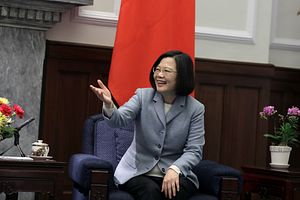Over the past few weeks, a number of activities tied to the commemoration of the 40th anniversary of the Taiwan Relations Act (TRA) on April 10 have spotlighted Taiwan’s relations with the United States as well as its role in the wider Indo-Pacific. One of the key aspects of this has been Taiwan’s New Southbound Policy (NSP) under President Tsai Ing-wen, which has sought to advance ties with select regional countries as part of the island’s wider foreign policy approach. Given the significance of the NSP for Taiwan at home and abroad, it is worth assessing where the initiative lies today as well as its prospects are looking further ahead.
As I have noted before in these pages, while previous governments in Taiwan have also sought to “look South” to diversify the country’s ties in a dynamic Asian region and to reduce dependence on mainland China, Tsai’s New Southbound Policy (NSP) – which got underway early on when she took office in May 2016 and focuses on strengthening ties with Southeast Asia along with South Asia, Australia, and New Zealand – constitutes a noteworthy advancement of efforts in this vein. The NSP seeks to advance ties between Taiwan and these countries in specific economic and people-to-people areas, including agricultural cooperation, medicine and public health, and youth exchanges.
Thus far, the NSP has begun to see some advances in terms of translating rhetoric into reality. Taiwan government statistics indicate increases in areas such as tourism, education, trade, and investment, some of which have surpassed previous targets. There has also been progress in some specific priority areas within the NSP as well, be it individual developments such as the conclusion of a Taiwan-Philippines bilateral investment agreement, which is to serve as an example for the advancement of economic ties with other target NSP countries, or the establishment of the One Country, One Center program in public health which has linked six Taiwanese hospitals with six Asian countries – Indonesia, India, Thailand, Malaysia, the Philippines, and Vietnam.
Beyond the metric of advancing ties with the specified regional states in question, the NSP has also generated positive knock-on effects for Taiwan internationally and domestically. Internationally, the NSP has provided a platform for Taiwan to partner with other countries and align strategies. For instance, it was no coincidence that during her remarks at this year’s iteration of the Indo-Pacific Security Conference on April 15, Tsai stressed to the audience that Taiwan would continue to find ways to link its own NSP with the U.S. free and open Indo-Pacific strategy (FOIPs) as one key manifestation of Taiwan’s contributions to the wider Indo-Pacific region. The United States and Taiwan have already been working toward this end through established mechanisms such as the Global Cooperation and Training Framework (GCTF), and both sides have also indicated efforts to work on initiatives including providing assistance with respect to the pursuit of infrastructure projects in Southeast Asia amid the issues evident in China’s Belt and Road Initiative (BRI).
Domestically, the NSP has also proven useful in helping Taiwan address lingering issues in its own society. In more candid, private conversations, those in government familiar with the advancement of the initiative note that the NSP’s role in increasing contact between Taiwan and other regional states can also help challenge certain perceptions that persist about other countries and also reinforce aspects of the country’s multiculturalism. To take just one example, the entry of a larger number and wider range people from Southeast Asian countries such as Indonesia, the Philippines, and Thailand can widen the lens of some in Taiwan who view the region primarily from the perspective of migrant workers and can also reinforce the need to better accommodate the needs of other racial and religious groups there.
Yet despite the inroads that the NSP has made thus far, it is not without its challenges and limitations. Internal to the government, there are issues such as resourcing and coordinating among a full range of stakeholders. More broadly, domestically, aspects of NSP’s advances abroad have also led to some concerns by some at home about how to manage some of the consequences for Taiwan at home, particularly when it comes to perceptions among some segments of the population about jobs or social cohesion. At the regional level, advancing certain aspects of NSP can at times still prove difficult with some governments who are cautious about getting in the crosshairs of cross-Strait relations.
Uncertainties lie further ahead as well. In particular, as the clock begins ticking down on Tsai’s current term in office ahead of upcoming elections in 2020, natural questions will surface about the sustainability of the initiative should she not be elected to a second term. Though the recognition of the importance of expanding Taiwan’s ties with other Indo-Pacific countries may be a shared general national priority irrespective of party affiliation, the continued success of the initiative will also partly rest on the degree of high-level commitment by future administrations that cannot necessarily be taken for granted.
Of course, these issues should not detract from the fact that the NSP thus far has proven to be an effective approach for Taiwan to diversify its foreign relations, to make inroads with regional states in the wider Indo-Pacific, to catalyze changes in its own society, and to partner with major powers in common lines of effort in the region and the wider world. But at the same time, they should reinforce the reality that the future prospects for the NSP will depend partly on how Taiwan addresses these issues even as it seizes new opportunities in the years to come.

































